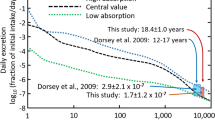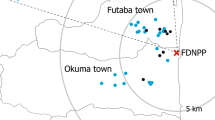Abstract
Depleted uranium (DU) is claimed to contribute to human health problems, known as the Gulf War Syndrome and the Balkan Syndrome. Quantitative radiation dose is required to estimate the health risk of DU materials. The influences of the solubility parameters in the human alimentary tract and the respiratory tract systems and the aerosol particles size on the radiation dose of DU materials were evaluated. The dose conversion factor of daily urinary excretion of DU is provided. The retention and excretion of DU in the human body after a contamination at a wound site were predicted. Dose coefficients of DU after ingestion and inhalation were calculated using the solubility parameters of the DU corrosion products in simulated gastric and simulated lung fluid, which were determined in the Helmholtz Zentrum München. 238U is the main radiation dose contributor per 1 Bq of DU materials. The dose coefficients of DU materials were estimated to be 3.5 × 10−8 and 2.1 × 10−6 Sv Bq−1 after ingestion and inhalation for members of the public. The ingestion dose coefficient of DU materials is about 75% of the natural uranium value. The inhalation dose coefficient of DU material is in between those for Type M and Type S according to the category for inhaled materials defined by the International Commission on Radiological Protection. Radiation dose possibly received from DU materials can directly be estimated by using the dose conversion factor provided in this study, if daily urinary excretion of DU is measured.
This is a preview of subscription content, access via your institution
Access options
Subscribe to this journal
Receive 6 print issues and online access
$259.00 per year
only $43.17 per issue
Buy this article
- Purchase on Springer Link
- Instant access to full article PDF
Prices may be subject to local taxes which are calculated during checkout







Similar content being viewed by others
References
AEPI. Health and Environmental Consequences of Depleted Uranium use in the U.S. Army: Technical Report. US Army Environmental Policy Institute, Atlanta, GA, 1995.
Bailey M.R., and Puncher M. Uncertainty Analysis of the ICRP Human Respiratory Tract Model Applied to Interpretation of Bioassay Data for Depleted Uranium. HPA-RPD-023. Health Protection Agency, Chilton, UK, 2007.
Bertell R. Depleted uranium: all the questions about DU and Gulf War syndrome are not yet answered. Int J Health Serv 2006: 36: 503–520.
Betti M. Civil use of depleted uranium. J Environ Radioact 2003: 64: 113–119.
Bleise A., Danesi P.R., and Burkart W. Properties, use and health effects of depleted uranium (DU): a general overview. J Environ Radioact 2003: 64: 93–112.
Bolch W.E., Farfán E.B., Huh C., Huston T.E., and Bolch W.E. Influences of parameter uncertainties within the ICRP 66 respiratory tract model: particle deposition. Health Phys 2001: 81: 378–394.
Bolch W.E., Huston T.E., Farfán E.B., Vernetson W.G., and Bolch W.E. Influences of parameter uncertainties within the ICRP-66 respiratory tract model: particle clearance. Health Phys 2003: 84: 421–435.
Briner W.E. The evolution of depleted uranium as an environmental risk factor: lessons from other metals. Int J Environ Res Public Health 2006: 3: 129–135.
Chazel V., Gerasimo P., Dabouis V., Laroche P., and Paquet F. Characterisation and dissolution of depleted uranium aerosols produced during impacts of kinetic energy penetrators against a tank. Radiat Prot Dosim 2003: 105: 163–166.
Durakovic A. Medical effects of internal contamination with uranium. Croat Med J 1999: 40: 49–66.
Durante M., and Pugliese M. Depleted uranium residual radiological risk assessment for Kosovo sites. J Environ Radioact 2003: 64: 237–245.
Fritsch P. Uncertainties in aerosol deposition within the respiratory tract using the ICRP 66 model: a study in workers. Health Phys 2006: 90: 114–126.
Fulco C.E., Liverman C.T., and Sox H.C. Gulf War and Health, Vol. 1, Depleted uranium, pyridostigmine bromide, sarin, vaccines. National Academy Press, Washington DC, 2000.
Gamble J.L. Chemical Anatomy, Physiology and Pathology of Extracellular Fluid. Harvard University Press, Boston, 1967.
Gerstmann U.C., Szymczak W., Höllriegl V., Li W.B., Roth P., and Schramel P., et al. Investigations on the solubility of corrosion products on depleted uranium projectiles by simulated body fluids and the consequences on dose assessment. Radiat Environ Biophys 2008: 47: 205–212.
Guilmette R.A., and Parkhurst M.A. Dose assessment for inhalation intakes in complex, energetic environments: experience from the US capstone study. Radiat Prot Dosim 2007: 127: 516–520.
Hamel S.C., Buckley B., and Lioy P.J. Bioaccessibility of metals in soils for different liquid to solid ratios in synthetic gastric fluid. Environ Sci Technol 1998: 32: 358–362.
Harley N.H., Foulkes E.C., Hilborne L.H., Hudson A., and Anthony C.R. Depleted Uranium, A Review of The Scientific Literature as it Pertains to Gulf War Illness. Titles in the Gulf War Illnesses series. Vol. 1. RAND's National Defense Research Institute, Santa Monica, CA, 1999.
Harrison J.D., Fell T.P., Pellow P.G.D., Phipps A.W., and Puncher M. Uncertainty Analysis of the ICRP Systemic Model for Uranium as applied to Interpretation of Bioassay Data for Depleted Uranium. HPA-RPD-024. Health Protection Agency, Chilton, UK, 2007.
ICRP. Limits for Intakes of Radionuclides by Workers. Ann ICRP 2(3–4) Pergamon Press, Oxford, UK, 1979.
ICRP. Recommendations of the International Commission on Radiological Protection. ICRP Publication 60. Ann ICRP 21(1–3). Pergamon Press, Oxford, UK, 1991.
ICRP. Human Respiratory Tract Model for Radiological Protection. ICRP Publication 66. Ann ICRP 24(1–3). Pergamon Press, Oxford, UK, 1994a.
ICRP. Dose Coefficients for Intakes of Radionuclides by Workers. ICRP Publication 68. Ann ICRP 24(4). Pergamon Press, Oxford, UK, 1994b.
ICRP. Age-Dependent Doses to Members of the Public From Intake of Radionuclides: Part 3: Ingestion Dose Coefficients. ICRP Publication 69. Ann ICRP 25(1). Pergamon Press, Oxford, UK, 1995a.
ICRP. Age-Dependent Doses to Members of the Public From Intake of Radionuclides: Part 4: Inhalation Dose Coefficients. ICRP Publication 71. Ann ICRP 25(3–4). Pergamon Press, Oxford, UK, 1995b.
ICRP. Age-Dependent Doses to Members of the Public from Intake of Radionuclides: Part 5 Compilation of Ingestion and Inhalation Dose Coefficients. ICRP Publication 72. Ann ICRP 26(1). Pergamon Press, Oxford, UK, 1996.
ICRP. Supporting Guidance 3. Guide for Practical Application of the ICRP Human Respiratory Tract Model. Ann ICRP 32(1–2). Pergamon Press, Oxford, UK, 2002.
ICRP. Human Alimentary Tract Model for Radiological Protection. ICRP Publication 100. Ann ICRP 36(1–2). Elsevier Sci. Ltd: Oxford, UK, 2006.
ICRP. The 2007 Recommendations of the International Commission on Radiological Protection. ICRP Publication 103. Ann ICRP 37(2–4). Elsevier Sci. Ltd, Oxford, UK, 2007.
Jia G., Belli M., Sansone U., Rosamilia S., and Gaudino S. Concentration, distribution and characteristics of depleted uranium (DU) in the Kosovo ecosystem: a comparison with the uranium behavior in the environment uncontaminated by DU. J Radioanal Nucl Chem 2004: 260: 481–494.
Li W.B., Roth P., Wahl W., Oeh U., Höllriegl V., and Paretzke H.G. Biokinetic modeling of uranium in man after injection and ingestion. Radiat Environ Biophys 2005: 44: 29–40.
Li W.B., Salonen L., Muikku M., Wahl W., Höllriegl V., and Oeh U., et al. Internal dose assessment of natural uranium from drinking water based on biokinetic modeling and individual bioassay monitoring: a study of a Finnish family. Health Phys 2006: 90: 533–543.
Marshall A.C. Gulf war depleted uranium risks. J Expo Sci Environ Epidemiol 2007: 18: 95–108.
McDiarmid M.A., Engelhardt S., Oliver M., Gucer P., Wilson P.D., and Kane R., et al. Health effects of depleted uranium on exposed Gulf War veterans: a 10-year follow-up. J Toxicol Environ Health A 2004: 67: 277–296.
Miller A.C., and McClain D. A review of depleted uranium biological effects: in vitro and in vivo studies. Rev Environ Health 2007: 22: 75–89.
NCRP. Development of a Biokinetic Model for Radionuclide-Contaminated Wounds and Procedures for their Assessment, Dosimetry and Treatment. NCRP Report No. 156. The National Council on Radiation Protection and Measurements, Bethesda, MD, 2007.
Oeh U., Li W.B., Höllriegl V., Giussani A., Schramel P., and Roth P., et al. Daily uranium excretion in German peacekeeping personnel serving on the Balkans compared to ICRP model prediction. Radiat Prot Dosim 2007a: 127: 329–332.
Oeh U., Priest N.D., Roth P., Ragnarsdottir K.V., Li W.B., and Höllriegl V., et al. Measurements of daily urinary uranium excretion in German peacekeeping personnel and residents of the Kosovo region to assess potential intakes of depleted uranium (DU). Sci Total Environ 2007b: 381: 77–87.
Oeh U., Roth P., Gerstmann U., Schimmack W., Szymczak W., and Höllriegl V., et al. Untersuchungen zur Gesundheitsgefährdung durch Munition mit abgereichertem Uran (DU). GSF-Report 03/05. GSF-National Research Center for Environment and Health, Neuherberg, Germany, 2005.
Parkhurst M.A., Szrom F., Guilmette R.A., Holmes T.D., Cheng Y.S., and Kenoyer J.L., et al. Capstone Depleted Uranium Aerosols: Generation and Characterization, Volumes 1 and 2. Report PNNL-14168. Pacific Northwest National Laboratory, Bethesda, MD, 2004.
Priest N.D. Toxicity of depleted uranium. Lancet 2001: 357: 244–246.
Roth P., Höllriegl V., Werner E., and Schramel P. Assessment of exposure to depleted uranium. Radiat Prot Dosim 2003: 105: 157–161.
Salbu B., Janssens K., Lind O.C., Proost K., and Danesi P.R. Oxidation states of uranium in DU particles from Kosovo. J Environ Radioact 2003: 64: 167–173.
Schimmack W., Gerstmann U., Oeh U., Schultz W., and Schramel P. Leaching of depleted uranium in soil as determined by column experiments. Radiat Environ Biophys 2005: 44: 183–191.
Schimmack W., Gerstmann U., Schultz W., and Geipel G. Long-term corrosion and leaching of depleted uranium (DU) in soil. Radiat Environ Biophys 2007: 46: 221–227.
Squibb K.S., and McDiarmid M.A. Depleted uranium exposure and health effects in Gulf War veterans. Philos Trans R Soc Lond B Biol Sci 2006: 361: 639–648.
The Royal Society. The Health Hazards of Depleted Uranium Munitions: Part I. The Royal Society, London, UK, 2001.
The Royal Society. The Health Hazards of Depleted Uranium Munitions: Part II. The Royal Society, London, UK, 2002.
UNEP. Depleted Uranium in Kosovo, Post-Conflict Environmental Assessment. United Nations Environment Programme, Nairobi, Kenya, 2001.
UNEP. Depleted Uranium in Serbia and Montenegro. Post-conflict environmental assessment in the Federal Republic of Yugoslavia. United Nations Environment Programme, Nairobi, Kenya, 2002.
UNEP. Depleted Uranium in Bosnia and Herzegovina. Post-Conflict Environmental Assessment. United Nations Environment Programme, Nairobi, Kenya, 2003.
UNEP. Lebanon. Post-Conflict Environmental Assessment. United Nations Environment Programme, Nairobi, Kenya, 2007.
UNEP/UNCHS. The Kosovo Conflict. Consequences for the Environment and Human Settlements. United Nations Environment Programme and United Nations Center for Human Settlements (Habitat), Nairobi, Kenya, 1999.
Valentin J., and Fry F.A. What ICRP advice applies to DU? J Environ Radioact 2003: 64: 89–92.
WHO. Depleted Uranium: Sources, Exposure and Health Effects. World Health Organization, Geneva, Switzerland, 2001.
Wise S.S., Thompson W.D., Aboueissa A.M., Mason M.D., and Wise J.P. Particulate depleted uranium is cytotoxic and clastogenic to human lung cells. Chem Res Toxicol 2007: 20: 815–820.
Zankl M., Becker J., Fill U., Petoussi-Henß N., and Eckerman K.F. GSF male and female adult voxel models representing ICRP Reference Man-the present status. In: The Monte Carlo Method: Versatility Unbounded in a Dynamic Computing World, 17–21 April 2005, on CD-ROM, Chattanooga, TN. American Nuclear Society, La Grange Park, IL, 2005, pp 1/13–13/13.
Zankl M., Eckerman K.F., and Bolch W.E. Adult male and female voxel-based models representing the ICRP Reference Man-the skeleton. Radiat Prot Dosim 2007: 127: 174–186.
Acknowledgements
This study was in part supported by the German Ministry of Defence under the contract no. InSan I-0701-V-3803. We thank Herwig G. Paretzke for support, and Augusto Giussani and Matthias Greiter for discussions on the model of gastrointestinal absorption of DU materials. We also thank the reviewers for valuable comments.
Author information
Authors and Affiliations
Corresponding author
Rights and permissions
About this article
Cite this article
Li, W., Gerstmann, U., Höllriegl, V. et al. Radiation dose assessment of exposure to depleted uranium. J Expo Sci Environ Epidemiol 19, 502–514 (2009). https://doi.org/10.1038/jes.2008.40
Received:
Accepted:
Published:
Issue Date:
DOI: https://doi.org/10.1038/jes.2008.40



